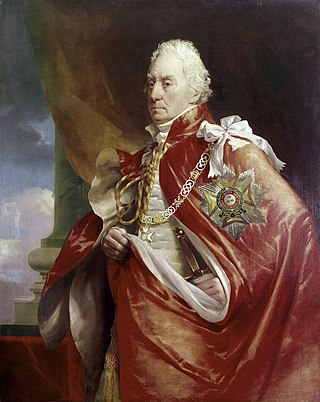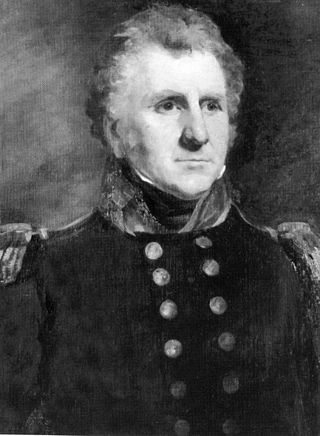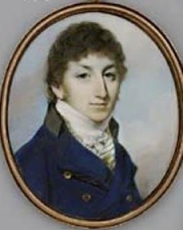
Lord Elphinstone is a title in the Peerage of Scotland created by King James IV in 1510.

George Keith Elphinstone, 1st Viscount Keith, was a British naval officer active throughout the Napoleonic Wars.

George Child Villiers, 5th Earl of Jersey, GCH, PC, previously George Villiers and styled Viscount Villiers until 1805, was a British courtier and Conservative politician from the Villiers family.

Major-General William George Keith Elphinstone CB was an officer of the British Army during the 19th century.
Lord Cardross is a title in the Peerage of Scotland, since 1695 a subsidiary title of the earldom of Buchan. It was created in 1606 for John Erskine, Earl of Mar, with remainder to his heirs male and assignees whatsoever and with the power to nominate his successor. In 1617 he nominated his second son by his second wife Marie Stewart, Henry Erskine, Master of Cardross, to be his successor in the lordship of Cardross. The Earl of Mar died in 1634 and was succeeded in the earldom of Mar by his son by his first wife, John, and in the lordship of Cardross by his grandson David Erskine, the second Lord Cardross, the son of Henry, Master of Cardross, who had died in 1628. The second Lord was a supporter of The Engagement and was barred from sitting in Parliament in 1649. He was succeeded by his eldest son, the third Lord. He emigrated to North America to escape religious persecution and established a colony in what is now Carolina. His son, the fourth Lord, succeeded his kinsman in the earldom of Buchan in 1695. However, it was not until 1698 that his claim was established by the Scottish Parliament. For further history of the title, see Earl of Buchan.

Admiral Sir Charles Adam was a British naval commander and Lord of the Admiralty who served during the Napoleonic Wars. He later commanded the royal yacht, Royal Sovereign, and was the Member of Parliament for Clackmannanshire and Kinross-shire. He held the office of First Naval Lord three times. In that capacity he dealt ably with the economies of a peacetime budget, provided naval support for the expulsion of Muhammad Ali's forces from Syria in 1840 and ensured technological progress continued. He was also the father of William Patrick Adam, a colonial administrator and Liberal politician.

Clan Elphinstone is a Lowland Scottish clan.
Alexander Mountstuart Elphinstone, 19th Lord Elphinstone and 5th Baron Elphinstone, is a Scottish peer in both the Peerage of Scotland and the Peerage of the United Kingdom.
Francis Godolphin Osborne, 1st Baron Godolphin, styled Lord Francis Osborne from 1789 to 1832, was a British politician.

Catherine Murray, Countess of Dunmore, was an English peeress and promoter of Harris Tweed.

William Buller Fullerton Elphinstone, 15th Lord Elphinstone and 1st Baron Elphinstone, known as William Elphinstone until 1861, was a Scottish Conservative politician.

The Dalrymple, later Dalrymple-Hamilton, later Hamilton-Dalrymple Baronetcy, of North Berwick in the County of Haddington, is a title in the Baronetage of Nova Scotia. It was created on 29 April 1697 for the Hon. Hew Dalrymple, Lord President of the Court of Session under the judicial title of Lord North Berwick from 1698 to 1737. He was the third son of James Dalrymple, 1st Viscount of Stair, and the brother of John Dalrymple, 1st Earl of Stair, Sir James Dalrymple, 1st Baronet, of Cranstoun, and Sir David Dalrymple, 1st Baronet, of Hailes. The second Baronet sat as Member of Parliament for Haddington and Haddingtonshire. The third Baronet represented Haddingtonshire in the House of Commons. The fourth Baronet was Member of Parliament for Haddingtonshire, Ayrshire and Haddington. He assumed the additional surname of Hamilton after that of Dalrymple. The fifth Baronet sat as Member of Parliament for Haddington. The eighth Baronet assumed the surname of Hamilton before that of Dalrymple. The tenth Baronet was Lord-Lieutenant of East Lothian from 1987 to 2001.

Hester Maria Elphinstone, Viscountess Keith, born Hester Maria Thrale, was a British literary correspondent and intellectual. She was the eldest child of Hester Thrale, diarist, author and confidante of Samuel Johnson, and Henry Thrale, a wealthy brewer and patron of the arts. She became the second wife of George Elphinstone, 1st Viscount Keith.

Admiral Hon. Charles Elphinstone Fleeming was a British officer of the Royal Navy who served during the French Revolutionary and Napoleonic Wars. He commanded a succession of smaller vessels during the early years of the wars, achieving some successes against French cruisers, merchants and privateers, before losing his ship on one operation. Combining his naval career with periods of political activity he took part in only one major fleet operation, the Battle of Cape Finisterre in 1805, but spent several years as a Member of Parliament. Connected by birth to a major noble landowning family several of his children went on to inherit or marry into titles and rank in the British peerage. Charles himself died an Admiral of the Blue with extensive Scottish estates.
Admiral John Elphinstone Erskine was a Royal Navy officer and Liberal politician who sat in the House of Commons from 1865 to 1874.
Elphinstone is a Scottish surname. It is locational from the lands of Elphinstone in the parish of Tranent.

Sir James Montgomery, 2nd Baronet Stanhope, FRSE was a Scottish politician and lawyer who served as Lord Advocate of Scotland 1804 to 1806.

The Invasion of the Cape Colony, also known as the Battle of Muizenberg, was a British military expedition launched in 1795 against the Dutch Cape Colony at the Cape of Good Hope. The Dutch colony at the Cape, established and controlled by the United East India Company in the seventeenth century, was at the time the only viable South African port for ships making the journey from Europe to the European colonies in the East Indies. It therefore held vital strategic importance, although it was otherwise economically insignificant. In the winter of 1794, during the French Revolutionary Wars, French troops entered the Dutch Republic, which was reformed into the Batavian Republic.

William Fullerton-Elphinstone was a Scottish ship's captain for the East India Company who became a director of the company several times between 1786 and 1824, and who served both as deputy chairman and chairman of the company.
William Forbes, 7th Lord Forbes (1513-1593) was a Scottish landowner.














